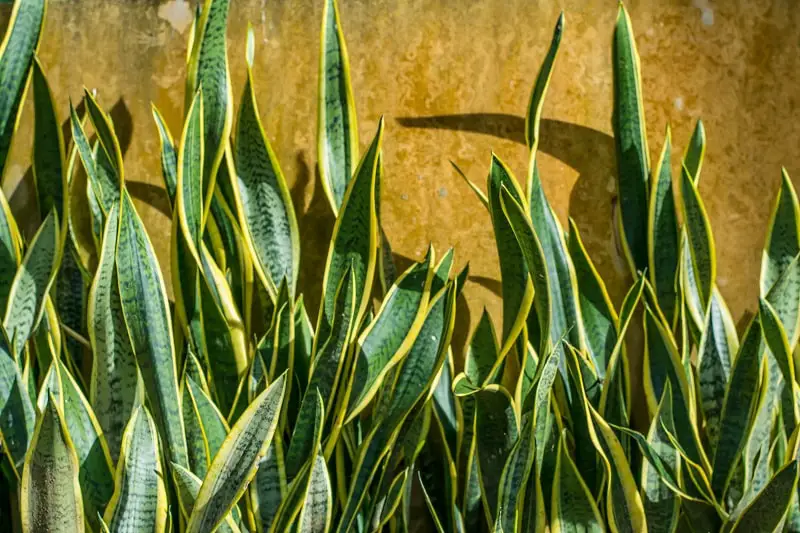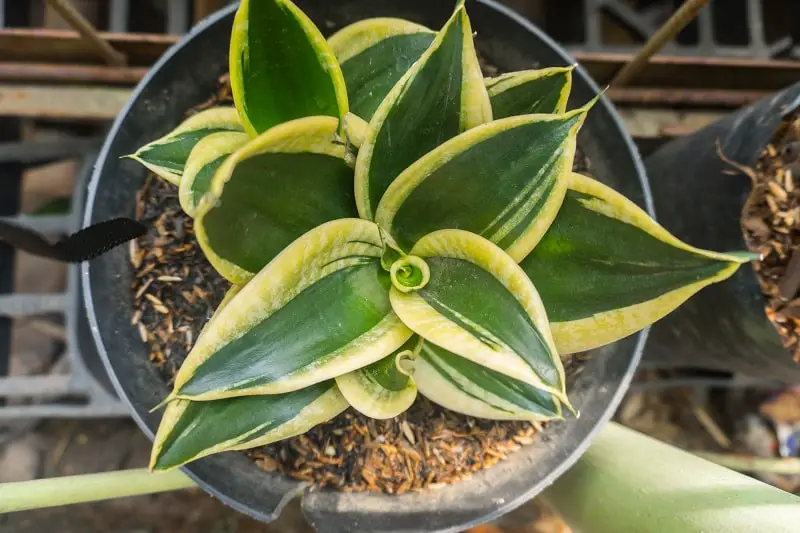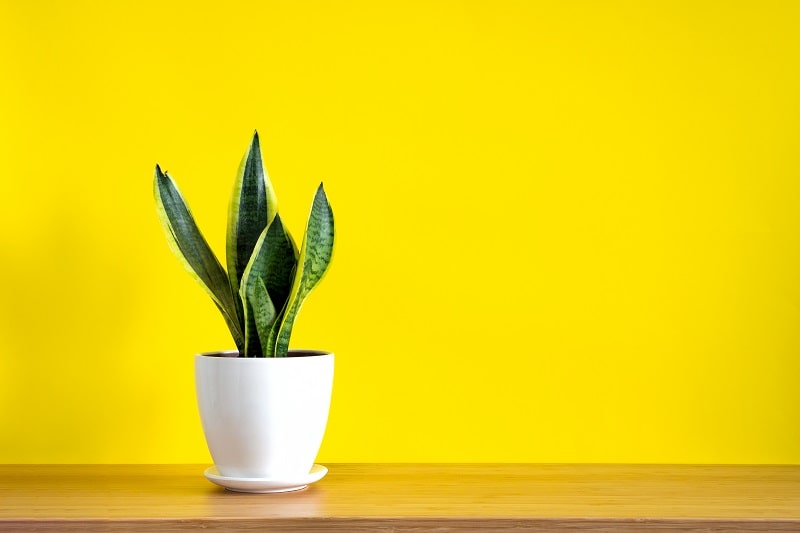The snake plant (Sansevieria) is one of the easiest indoor plants to grow. Thus, one of the reasons behind the popularity among many homeowners in the United States of America.
The houseplant is also known as snakeskin and mother-in-law’s tongue. The hardy succulent stems make the plant to survive in extreme conditions.
But this does not imply that the houseplant cannot succumb to problems. The snakeskin plants do experience problems like other indoor plants.
So, why is my snake plant leaves turning yellow? The most common reasons for yellowing of snake plant leaves are overwatering, cold temperatures, nutritional deficiencies, pests and improper light. Diagnosing the problem will help to identify the best method of fixing.
Keep reading to find out the reasons for snake plant leaves turning yellow and soft. You will also get to learn some ways on how to save the yellowing snake plant.

You May Also Enjoy: Why Are My Snake Plant Leaves Curling?
Main Reasons for Snake Plant Leaves Turning Yellow
The blades of snakeskin plants will be turning yellow for a number of reasons. It is quite to investigate some of the causes before finding methods on how to them.
Here are some of the possible causes:
Overwatering the Plant
A healthy snake plant has dark green leaves. It is one of the indicators that demonstrate the grower is taking good care of the indoor plant.
Overwatering the plant is quite dangerous. It is the roadmap of killing the houseplant in advance, and this cannot be very reassuring.
The snake plant leaves turning white or yellow implies that there is something not being done right. The first possible cause is overwatering, which needs to be corrected.
Excess moisture in the soil causes the plant to experience root rot. The disease makes houseplants to be unable to encourage the flow of water and minerals from the ground.
You May Also Enjoy: How Often to Water Snake Plant
Too Much Sunlight Exposure
Snake plants thrive in an area receiving bright indirect light. The filtered light allows the plant to undertake photosynthesis to maintain the dark green colors.
But overexposing the snake plant to direct sunlight could be the possible cause of the yellowing of leaves. The leaves’ color changes since the plant are losing more water.
If you notice the snake plant leaves turning yellow from the bottom, consider changing the plant’s location. Keeping the houseplant in the darkroom for a while will help to restore the colors.
Underwatering the Indoor Plant
Snake plant receiving inadequate water is likely to show yellowing of leaves. It happens since the leaves lack moisture to facilitate its dark green colors.
Besides that, inconsistent watering poses much stress to the plant and makes the leaves start turning yellow. Addressing the problem might restore the vibrant dark green colors.
Sometimes, the lack of water may result in several snake plant problems. Why is my snake plant turning brown? Well, the possible cause of the problem is dry soil due to lack of water.
Cold Temperatures
Sanseveria plants are tropical plants. It means that the plant cannot survive in adverse cold temperatures like that of winter.
The freezing weather damage the leaves. It also results in the formation of snake plant yellow mushy leaves. The condition can kill the plant if immediate action is not taken.
But the problem usually happens to those growers venturing into outdoor snake plant gardens. Keeping the plant warm during winter is the right direction to consider.

Over-Fertilization
Sanseveria plant is not a heavy feeder. But if you are looking for better growth, then the application of fertilizer is advisable. Keep in mind that this process should be done in spring and summer.
It would be best to consider applying fertilizer if there is a sign of need. Overfeeding is likely to kill the plant. The direction causes the plant leaves to start turning yellow.
Fertilizing the plant in winter is a wrong decision. This is the period when the snake plant is dormant, and there will be no absorption of nutrients.
Over-Crowded Pot
Congestion is another cause of snake plant leaves turning yellow and soft. The situation happens since there is stiff competition for insufficient nutrients from the soil.
Dividing the plant into smaller bundles and repotting to a larger container is the best solution. It will help to combat nutrients and mineral competition.
Aging of the Plant
The natural aging process is the leading cause of snake plant leaves turning yellow from the bottom. You will notice plantlets growing from the center and old leaves from the outer perimeter.
The yellowing and dying of old leaves is a natural cycle. There is no need to freak since the plant will later get rejuvenated by the growing pups.
Pest Infestation
Mealybugs and aphids are the common insect infestation of the plant. These pests usually suck plant sap and moisture. The yellowing of leaves manifests the condition.
Most of these insects are tiny, and it is quite challenging to be identified on the plant. But you will notice the snake plant leaves turning white.
Fungal Diseases
Overwatering is the leading cause of fungal diseases in snake plants. Also, overcrowding the plants in a container could cause fungal infections.
Fungal diseases affect the overall growth of the plant. It increases the chance of the snake plant leaves to turn yellow and soft.
It is crucial to consider snake plant fungus treatment to restore the health of the houseplant. It is the best way to prevent snake plant yellow mush leaves.
Insufficient Nutrients and Minerals
Minerals and nutrients are vital for the growth of the sansevieria plant. Growing snake plant in a soil rich in nutrients facilitates healthy growth and development of dark green leaves.
Subject snake plant to insufficient nutrients and minerals would be the possible cause of yellowing of leaves. The plant later experiences stunted growth and pest infestation.
The indoor plant thrives in soil rich in magnesium, nitrogen, and phosphorus. These ingredients help the plant to flourish.
Soil pH
Snake plants attain their full potential when grown in a suitable soil pH of about 6.0 to 6.5. The grower needs to conduct soil testing before increasing the sansevieria plant.
Planting the plant in soil pH out of these scale points will trigger yellowing and even the leaves’ browning. Sometimes, the plant ends up dying if corrective measures are not considered.
You May Also Read: How to Propagate Snake Plants
How Do You Save Yellowing Snake Plant?
Proper snake plant care is quite essential. It helps the plant to survive and grow to its full potential. The grower needs to watch for the yellowing of plant leaves and immediately fix the snake plant problems.
Here are measures for fixing snake plant leaves yellowing and getting soft. These tips are part of ways how to grow and care for snake plants. They include:
- Put the plant in a location where it receives bright indirect sunlight. The aim is to prevent excessive light exposure, making snake plant leaves turn brown.
- Consider snake plant fungus treatment. But it would be best if you kept an eye on various symptoms of fungal diseases like the yellowing of leaves.
- Providing the plant with the right amount of water is paramount. It will help avoid overwatering and underwatering the snake plant.
- Proper fertilization is essential since it provides vital nutrients and minerals to the plant.
- Provide warmth to the plant during the winter season. It is the period when there is a freezing temperature in the environment. It will prevent the snake plant yellow mush leaves.

In Conclusion
Keeping the sansevieria plant healthy by providing the required amount of nutrients, sunlight, and water is the best way to prevent leaves’ yellowing.
Be sure to use well-drained soil and make holes at the bottom of the container. The aim is to prevent soggy soil from occurring.
Besides that, take good care of the plant and experience vibrant colors in your indoor space. The vibrant color is a clear indication of a healthy snake plant.
You Can Also Read:

My spider plant started turning yellow on some leaves. Thank you for the tip about the kind of water, in my city the faucet water has fluoride. I have a few babies in a glass and they’re loving life.
The bottom of my spider plant is going brown after I split it. Also a lot of the leaves are turning yellow and brown. Any suggestions?